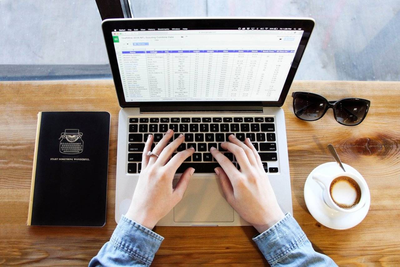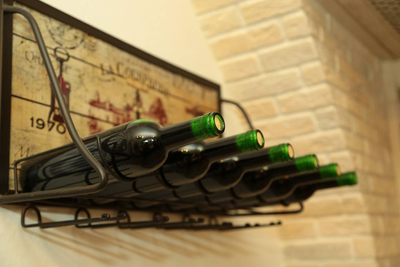What is a Wine Inventory Spreadsheet?
A wine inventory spreadsheet is a simple, tabulated document used to record wine stocks in a home, bar or restaurant. It's a tool commonly used in inventory management. Rows and columns on the spreadsheet organize wine by several criteria, including brand, variety, origin, vineyard, purchase date, cost, date of maturity, ageing limit, and ideal wine temperature. A wine inventory spreadsheet can be paper-based or electronic. Excel and Google Sheets are popular programs used to generate inventory spreadsheets.
Wine Inventory Spreadsheet- Everything You Need to Know
What is a Wine Inventory Spreadsheet?
A wine inventory spreadsheet is an inventory document used by owners and managers of wine stocks to help them track wine levels, expenses, and earnings. They are managed manually, with the inventory-taker feeding information into the relevant columns. Wines can be organized by brand, vintage, region, vineyard, purchase date, cost, date of maturity, ageing limit, ideal wine temperature, and tasting notes.
Inventory spreadsheets can be paper-based or electronic, with Microsoft Excel template, Google Sheets, and Apple's Numbers popular software programs used to create and edit them. Wine inventory spreadsheets can be used by small business wine cellar owners, home-based cellars, and by small restaurants to manage their inventory.
For restaurant and bar owners tasked with myriad duties, maintaining a separate inventory for wine can be onerous, confusing, and time-consuming. (Wines, liquors, and beers are typically inventoried separately in a retail establishment.) But with the right inventory tools a bar's wine collection and wine bottle count can be easily organized and monitored. Moreover, not every restaurant or bar owner, or individual wine connoisseur has access to inventory management software. Wine inventory spreadsheets provide an inexpensive inventory solution to such folks.
Why Do I Need a Wine Inventory Spreadsheet?

Wines are an expensive investment, and wine cellar managers have to make sure every bottle is optimized. This is why wine inventory management is of the utmost importance. A wine inventory spreadsheet, be it an Excel spreadsheet or Google Sheets, is a low-cost data collection tool that can give you all the information you need about your wine cellar.
Here are 5 reasons why wine cellar managers need to keep inventory spreadsheets-
- Tracking wine types in a wine cellar
- Tracking aging and wine maturity
- Tracking purchase and sales
- 1-2 years- White wine
- 2-3 years- Red wine
- 10-20 years- Fine wine (Provided it's stored well)
(Information courtesy Healthline.com)

You need to know how much wine you have on hand, but it’s hard to keep track of every bottle.
It’s easy when you have wine inventory spreadsheets to help. Have you tried them out yet?
How to Inventory Wines Using a Wine Inventory Spreadsheet?

Wine inventory involves the organization and tracking of wine bottles in a restaurant or wine cellar. There are ways and ways to inventory wine using a wine inventory spreadsheet, each depending on the organizational method you as a home-cellar owner, or bar or restaurant manager find most effective. Here are three super simple methods to get started-
1. Counting bottles and hiving them into two categories-
Single unit- Sealed and full bottles are counted as single unit bottles.
Opened bottles- Bottles that are half-full can be written as 0.5%, meaning that they are 50% full. If the bottle is a quarter full, enter it as 0.25%, that is 25% wine left over in the bottle.
2. Using The Wine Bin Optimally-
Wine in a cellar can be inventoried according to the bins or wine racks that hold them. Bins in turn can be organised by varietal, region, producer, or maturity date. They can also be labeled on the spreadsheet according to location in the cellar or bar- back-left; lounge, and so on.
3. Using Wine Tags-
Wine tags contain information related to a wine's manufacture, region, and tasting notes. The same information can be entered into the tag column of the inventory spreadsheet, making it easy to pick wine for a particular season, occasion, or customer demand.
Where Can I Find the Best Wine Inventory Spreadsheets?
It's easy to create your own wine inventory spreadsheet templates from a range of options available onlinemany of which are free. Sites like Pinterest and Reddit have scores of ideas for those keen to build their inventory spreadsheets from scratch. If you have no time for that sort of thing, you can download a spreadsheet template and either use it digitally or as a print-out. Some templates can be modified, allowing you to edit the files and add new columns according to your inventory needs. We've rounded up the best of them here . . .
1. Microsoft Office
My Wine Collection is a free to download Excel spreadsheet. Its pre-set categories include wine name; winery/ vineyard; sweet/ dry; color; serving instructions; alcohol percent; market value of bottle; and so on. This rudimentary template is best suited for home-based inventories.
2.Binwise
The inventory management solutions company, Binwise, offers a free-to-download, editable wine inventory spreadsheet on its website. The spreadsheet can be used on Google Sheets or Microsoft Excel. It comes with red and white tabs, along with columns for cost, count and formatting.
3. SpreadsheetMan.com
The SpreadsheetMan Wine Bottle Inventory Tracker is a comprehensive inventory list, with three sheet tabs- bottle list; bottle by country & vintage; tastings. Each tab is beautifully formatted, with a broad range of categories, including a column for rating in the tastings sheet. Available as a view-only option on Google Sheets, edit access can be requested from the owner. Alternatively, each sheet tab can be simply copied to a fresh document. Templates with upgraded features can be purchased from the site.
How Can a Wine Inventory Spreadsheet Influence Menu Pricing?
Wine is a premium alcohol and serving wine can become a profitable business. But only when priced right. Wine inventory spreadsheet plays a crucial role in pricing wines for retail. Casual restaurant usually stock around 10-12 varieties of wines in their wine inventory and typically retail it 200%-300% higher than the wholesale price. A $15 bottle, for example, would retail between $55-$75 in a resto-bar. But a fine-dine concept can easily manage a 300%-400% markup.
Restaurants usually sell wine by the glass or by the bottle. Once the retail markup for a bottle is decided, setting the bottle menu price is a no-brainer. Wine by the glass however is a different ballgame. It presents bar owners with a unique pricing opportunity that can boost profits and minimize wastage. Let's consider an example- let's say you buy ten wine bottles at the wholesale price of $10 per bottle, and serve one glass of wine at $10. One wine bottle serves up to five glasses of wine. Each bottle therefore stands to earn $50, reaping a profit of $40 per bottle. By gathering all the sales stats on a single page, a wine inventory spreadsheet can help calculate pour cost and set profit margins easily.
A spreadsheet can also track seasonal shifts in consumer demand, highlighting popular varietals. In summer and springtime, for example, Sangriaa sweet, fruity, chilled drink with wine as its core ingredientis the preferred alcoholic beverage. At Christmas, restaurants serve mulled wine. This is red wine seasoned with aromatic herbs like cinnamon, star anise, orange slices and cloves. Perhaps the clientele at a particular bar or restaurant don't like mulled wine. Tracking sales for the particular variety of red wine used in mulled wine preparations will let a bar owner know if more of that wine needs to be ordered or not. In the same way, a bar owner can rethink pricing and conjure promotional campaigns and special food pairings to move the unpopular wines along by studying the inventory spreadsheet.

The last thing you want in your wine cellar is deadstock.
How do you make sure you don’t end up with wine that isn’t selling? How about a wine inventory spreadsheet?
What's Better? A Wine Inventory Spreadsheet or a Wine Inventory App?

Here are 3 reasons to choose a wine inventory spreadsheet app over a printout-
- Printed spreadsheets have limited use-
2. Anytime access-
A cloud-based inventory spreadsheet app also gives you access to your inventory data anytime, anywhere, with authorized access to multiple (trackable) users to update inventory. Moreover, the data can be integrated with your POS (point of sales) system, giving you an overview of your daily business.
3. Spreadsheet paperwork-
Whether you own a personal wine cellar or manage a commercial cellar, you'll have to keep track of your purchase orders. You may want to calculate your total outlay on your order history for, say, the past year, or a particular varietal. Retailers have to additionally calculate sales and analyse bottom lines. This involves a fair bit of math. Inventory software does the math for you, immediately and without error.
4. Paper spreadsheets need manual data entry-
A wine inventory spreadsheet app uses barcode scanners to procure and manage data. These scanners store detailed information about every wine bottle in a cellar, including varietal and retail price without someone having to write them down. Paired with Bluetooth or Wifi-enabled weighing scales, they automatically record wine stocks, seamlessly transferring the measures into a central database.
When Should You Upgrade From a Wine Inventory Spreadsheet to an App?
As long as your wine stocks are modest and manageable by a few pairs of hands, a simple inventory spreadsheet is alright. But if you're looking to scale upeither your cellar and/or your business, or if you plan to venture into new markets, you must upgrade from a wine inventory spreadsheet to a wine inventory application. While a wine inventory spreadsheet can help audit your day-to-day inflow and outflow of wine, it falls embarrassingly short when bottlesor business needsmultiply. A proper wine management software caters to end-to-end business needs, from ordering, to re-ordering.
Guests will be better served when information they seek on a particular wine if offered promptly. Or when the right recommendations are made, based on easily accessible tasting notes. These are features that a wine inventory app can provide.
Integrated with a restaurant or bar's POS system, customer preferences and contact details can be recorded for targeted marketing. This will help build a devoted clientele. Low-stock alerts picked up by the inventory app ensures bottles never run dry, while deadstock alerts guide better ordering decisions for the future. But the winning argument for wine inventory apps has to be speed and efficiency, with inventory time saved and inventory errors avoided.

Isn’t it embarrassing to have to tell a customer you’ve run out of their favorite wine?
Stay on top of your stock with a wine inventory spreadsheet and you’ll never run out again.

